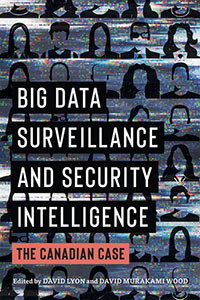
Big Data Surveillance and Security Intelligence: The Canadian Case
By D Lyon and D Wood (UBC Press (2020))
Reviewed By Gregory B. Mitchell, 3 September, 2024
The book is a 290-page, edited volume of scholarly articles, intended to provide new perspectives on employment of Big Data Surveillance in the security intelligence sector of Canada’s Intelligence Enterprise (CIE). It is the product of a 2017 conference sponsored by the Social Sciences and Humanities Research Council (SSHRC) as part of a large-scale, five-year, multi-partner research project. The project’s centre of gravity is the Surveillance Studies Centre at Queens University, where both Editors are directors. Their primary focus in this publication is the “…relative lack of critical reflection on the limits on, and ethics of, what can be achieved using [big data surveillance]” (p.4). Their position is quite clear when they state:
Above all, the pernicious technocentric story of endless and unstoppable technical progress must be challenged when it comes to security intelligence agencies, because their activities can profoundly yet often silently and secretly affect human rights, civil liberties, and the condition for human flourishing in Canada (p.31).
The volume is clearly an academic publication that successfully provides new knowledge and perspectives to the body of publicly available knowledge in what is otherwise a very secretive arena. Its greatest strength rests with the well-researched and persuasive argumentation provided by Editors and authors alike, which ensure the book’s overall success in addressing a spectrum of Big Data Surveillance issues not only of interest to Canadian Intelligence clients and practitioners, but more directly pertinent to those engaged in legal, privacy, review, and oversight issues.
There seems to be a consensus amongst the authors on the need to determine “…how the movement towards big data…can be controlled and held accountable, and… [the CIE’s] powers and reach in some cases rolled back” (p.30). Their arguments are worthy of careful consideration, especially given the inevitability of the continued growth of the use of Big Data Surveillance by the Five Eyes Intelligence community (in which Canada readily participates), and the fact that it is no longer a matter of whether, but of how CIE engages in Big Data Surveillance.
Despite the authors’ detailed research, their reasoned arguments, and their impressive academic and experiential credentials in the fields of sociology, criminology, law, or civil liberties, the book’s major weakness is in the unbalanced perspectives it presents. It does not include articles by representatives of the CIE, its clients, its executive authorities, or from those who provide intelligence review and oversight. Fortunately, the volume’s Afterword is provided by another respected expert who, alone among the contributing authors, possesses substantive operational experience within the Communications Security Establishment Canada, and her contribution to this volume injected a modicum of balance and enhanced the book’s overall credibility considerably. Her commentary is direct, relevant, and highly persuasive, providing that much-needed experiential perspective required to balance the other contributions and adding significant weight to the value of this book. She suggests that, if we accept that collecting bulk datasets for cyber security is an inescapable part of the national security picture (which it is), then we must understand the implications. The questions she then poses for future research would presumably meet the intent of the broader SSHRC project by raising such issues as reduced expectations of privacy, the role of private sector entities in cyber defence, vulnerability of our methods, systems, and processes, and perhaps the most important question of all: “To what extent are we handing over potential life and death decisions to machines?” (p.284).
References
Government of Canada. (2021). Social Sciences and Humanities Research Council. Retrieved at https://www.sshrc-crsh.gc.ca/home-accueil-eng.aspx
Lyon, D., and Wood, D. (2021). Big Data Surveillance and Security Intelligence: The Canadian Case. Vancouver Toronto: UBC Press. Retrieved at https://books.google.ca/books?hl=en&lr=&id=HSAMEAAAQBAJ&oi=fnd&pg=PP1&dq=big+data+surveillance+and+security+intelligence&ots=-j5dngJnVh&sig=uOLiO1_ZByNkVK752nT8LThncpI#v=onepage&q=big%20data%20surveillance%20and%20security%20intelligence&f=false
Queen’s University. (2022). Surveillance Studies Centre, website. Retrieved at https://www.queensu.ca/research/centres-institutes/surveillance-studies-centre
